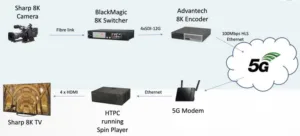On May 11, Sharp USA had a webinar on 8K titled “Beyond 4K: Exploring Sharp’s 8K Ecosystem.” Since Sharp has said it will not be a US television supplier, the webinar focused on professional use of 8K technology. Presenters were Cliff Quiroga, VP New Business Development, and Saundra Merollo, Senior Sales Engineer, with Manny Cuza, Regional Account Manager – Pro AV, acting as host and moderator.

 Partners in the 8K Ecosystem (Credit: Sharp)
Partners in the 8K Ecosystem (Credit: Sharp)
Sharp makes 8K camcorders and 8K displays, but not the intermediate products needed to form a complete ecosystem. These products are supplied by Sharp’s Star Partners, not by Sharp itself.
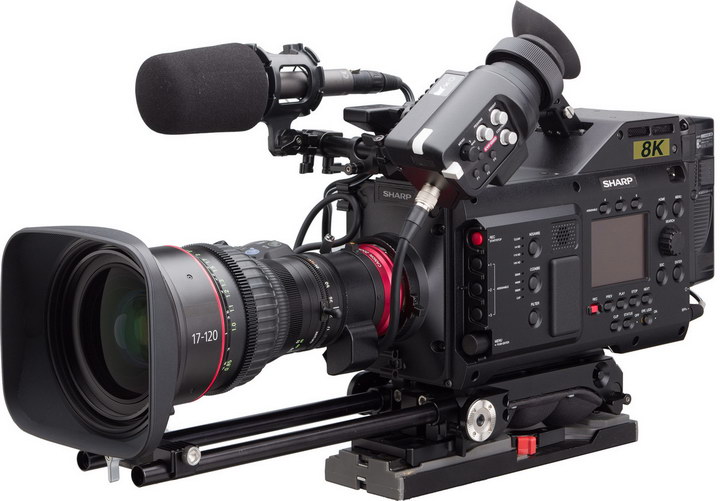 Sharp’s 8C-B60A 8K Camcorder. (Credit: Sharp)
Sharp’s 8C-B60A 8K Camcorder. (Credit: Sharp)
Sharp currently sells one 8K camera and has announced a second. The first, the Sharp 8C-B60A, was announced in November 2017 and is currently available in Japan or by special order in the US. It was priced at ¥8,800,000 without the PL-mount lens, about $77,000 at the 2017 exchange rate. This camera will do 8K (7680×4320, actually UHD-2) at a 60p frame rate with 4:2:2 compression and 10 bits. Not surprisingly, since the camera was developed with NHK, the native OETF (gamma) curve is HLG, not PQ. The camera uses the Grass Valley HQX Codec and will record 40 minutes of video content using a 2T SSD. According to Quiroga, this camera was developed specifically so NHK could broadcast the 2020 (now 2021) Olympics in 8K.
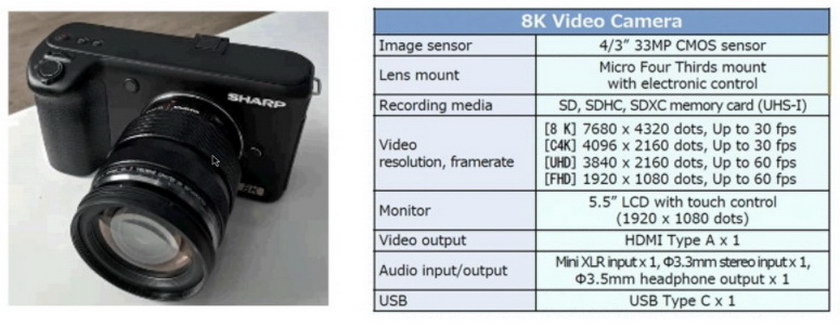 Sharp B30 8K Camera. (Credit Sharp)
Sharp B30 8K Camera. (Credit Sharp)
The second camera was first discussed at CES 2019 but is not yet available. According to Quiroga, it will be available in Japan in Q3 2020 and in the US in Q4. The price will be less than $4000. Complete data is not available on the camera but Quiroga gave the above table, which is more information on the camera than I’ve seen other places. The camera will record 8K (7680 x 4320) or true 4K (4096 x 2160) at 30fps. It will also record UHD or 1080p at 60fps. In one way, the 30fps limit for 8K is surprising: Sharp gives a convincing demo (if you need convincing) on its 8K TV website that 30fps is not enough for 8K content. In another sense, the 30fps limit is not surprising: the high-speed electronics to do 8K 60fps or, heaven forbid, 8K 120fps can hardly be built into a $4000 camera, at least not today. The camera takes a Micro Four Thirds lens, not included in the $4000, but these lenses are available from a variety of vendors, including Panasonic, Olympus and Sigma.
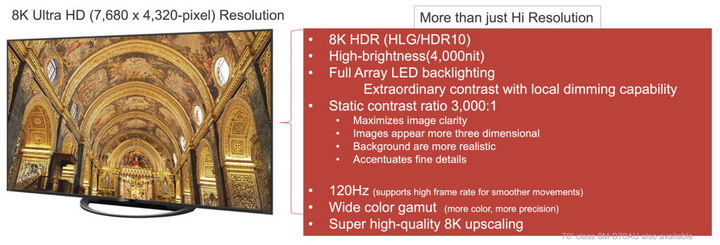 Sharp 8M-B80AX1U 8K, HDR, WCG and HFR professional display. (Credit: Sharp)
Sharp 8M-B80AX1U 8K, HDR, WCG and HFR professional display. (Credit: Sharp)
These two cameras are at one end of the 8K ecosystem chain and 8K displays are at the other end. They discussed two professional 8K displays from Sharp in the webinar, the 80” 8M-B80AX1U and the 70” 8M-B70AU. Sharp also makes a smaller 8K display for the consumer market, the 60” Aquos 8T-C60AX1X, but that was not discussed. To a certain extent, this failure to build a 60” professional 8K display emphasizes that 8K is really only for big screens where viewers are close to the screen and makes little sense in displays as small as 60”.
As Ken Werner discussed in a Display Daily almost a year ago, 8K is more than just more pixels. To make sense, it must be High Dynamic Range (HDR), Wide Color Gamut (WCG) and, preferably, High Frame Rate (HFR). The 80” display is all three of these with 4000 nits peak brightness, Rec. 2020 colorimetry and 120Hz frame rate. According to Sharp, these displays both have one thing that will be key for practical use of 8K displays: “Super high-quality [FHD and 4K to] 8K upscaling.” These displays aren’t particularly new. For example, the 70” version won a number of “Best in Show” awards in 2018.
Live streaming of 8K images over a 5G network in 2019 (Credit: Sharp)
Between the camera and the display, Sharp and its partners have demonstrated end-to-end 8K signal chains with various configurations for an assortment of markets. For example, the image above shows the configuration used for live, 8K streaming of the Roland-Garros French Tennis Open in May and June, 2019.
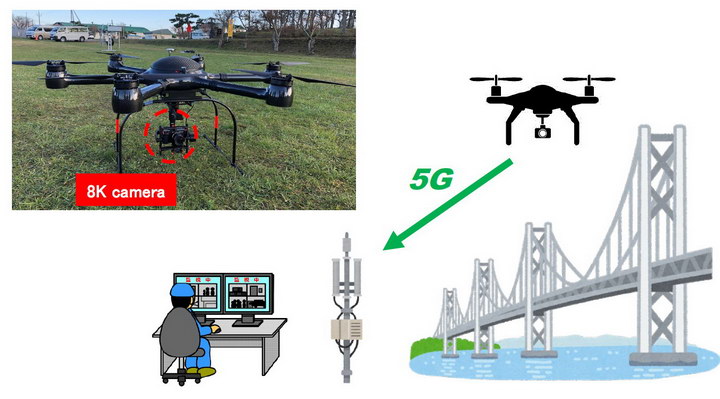 8K live streaming from drone to check infrastructure (Credit: Sharp)
8K live streaming from drone to check infrastructure (Credit: Sharp)
Sharp and its partners were the first to broadcast 8K live streaming from a drone in November 2019. The drone carried one of the soon-to-be-released B30 8K cameras, so the streaming must have been done at 30fps. Presumably, this camera was used due to the weight restrictions of the drone would not allow it to carry the larger 8C-B60A 8K camcorder. The signal was streamed using “local 5G” technology, which presumably means 5G mmWave point-to-point technology that does not access the 5G cellular network. While this demo was discussed at CES 2020 in terms of infrastructure inspection, as shown in the image, what the demo actually did was stream live 8K images of a thoroughbred race horse training sessions to horses’ owners around the world.
In many ways, 8K is not really a consumer distribution format, partly because of its cost, partly because of the bandwidth required and partly because a consumer, even one with an 8K display, can’t really see the difference between 4K and 8K in most cases. One thing acquisition with 8K cameras does allow is pan, scan and digital zoom to full-resolution FHD or UHD images without adjusting the camera position or the zoom of the lens. In the race horse training example, multiple horses were running together. One owner in Ireland could focus on his horse while another owner in Argentina could focus on a different horse and they would both still see high resolution images.
Another example given in the webinar was using one 8K camera on a newscast set. The 8K image would include both of the newscasters on the set. The 8K image could then be decimated to FHD or 4K to give the whole set, or a full resolution image of either newscaster could be generated. Thus, one 8K camera would replace three FHD or 4K cameras, and their operators. If desired, a digital zoom from the whole set onto just one of the newscasters could be done electronically, without the camera operator needing to do anything.
An infrastructure inspection topic discussed at CES was the inspection of sewers by a single 8K camera mounted on a robot that could crawl through the sewer. If the inspector saw anything suspicious, he could digitally zoom in on the potential problem and still get a very high-resolution image, eliminating the need for a pan and tilt mechanism on the robot or a zoom lens on the camera.
Other professional applications suggested by Quiroga and Merollo include digital signage, where viewers can approach the display closely; sports arenas, including VIP suites; telemedicine, including both surgery and education; and museums where people could see close up images and the undersides of artifacts that are too valuable for people to handle. While 8K resolution as a consumer distribution format faces a cloudy future, 8K acquisition and streaming has professional applications, including acquisition of consumer content to be streamed for broadcast at lower resolution, that pretty much guarantee its success. – Matthew Brennesholtz

